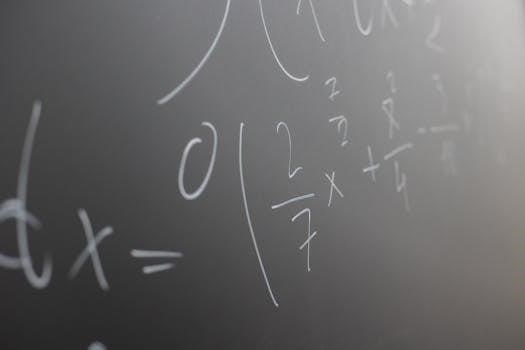The Math Placement Test at George Mason University (GMU) serves a crucial purpose⁚ determining a student’s readiness for specific math courses․ It doesn’t grant course credit or waivers, but rather assesses existing math skills․
Purpose of the Math Placement Test
The primary goal of the GMU Math Placement Test is to accurately assess a student’s current mathematical knowledge and skills․ This assessment helps determine the most appropriate math course for the student’s initial enrollment at George Mason University․ The test does not grant course credit or waivers; instead, it ensures students begin their math coursework at a level where they can succeed, building a solid foundation for future studies․ By evaluating proficiency in areas like pre-algebra, algebra, and geometry, the placement test aims to prevent students from being placed in courses for which they are underprepared, which could lead to frustration and difficulty․ Conversely, it also helps avoid placing students in courses that are too basic, ensuring they are challenged and engaged․ The ultimate objective is to optimize the student’s learning experience and academic progress in mathematics․

Courses Requiring the Placement Test
The GMU Math Placement Test is a prerequisite for enrollment in several mathematics courses at George Mason University․ Specifically, students planning to take MATH 105 (Precalculus), MATH 108 (Business Calculus), MATH 113 (Calculus I), MATH 123 (Calculus I with Precalculus ⏤ Part A), and MATH 125 (Discrete Mathematics) are required to take and pass the placement test before they can register for these courses․ The purpose of this requirement is to ensure that students possess the necessary foundational skills to succeed in these courses․ If a student’s initial placement test score does not meet the required level for a desired course, they may need to improve their math skills and retake the test․ Successfully passing the placement test demonstrates readiness and increases the likelihood of academic success in the chosen math course․ Students should consult the GMU Department of Mathematical Sciences for any updates or changes to this list․

Test Content and Structure
The GMU Math Placement Test covers three main areas⁚ Pre-Algebra, Algebra, and Geometry․ Focusing preparation on these topics ensures efficient study, excluding irrelevant material and maximizing study time effectiveness for the test․
Pre-Algebra Topics
The Pre-Algebra section of the GMU Math Placement Test includes fundamental concepts such as whole numbers, fractions, and decimals․ Expect questions involving operations with these numbers, including addition, subtraction, multiplication, and division․ Furthermore, the section will test knowledge of percents, proportions, and basic geometry principles․
Students should be comfortable converting between fractions, decimals, and percentages․ Understanding ratios and proportions is vital, including solving problems involving scale and similarity․ Geometric concepts involve area, perimeter, and volume calculations for simple shapes․ Familiarity with units of measurement and conversions is beneficial․
Practice problems should focus on applying these concepts in various contexts․ Reviewing order of operations (PEMDAS) is essential to avoid calculation errors․ Mastering these Pre-Algebra topics will provide a solid foundation for success on the Math Placement Test, increasing the likelihood of a favorable placement result․
Ensure a thorough understanding of these foundational skills to confidently tackle the Pre-Algebra questions and advance through the test․
Algebra Topics
The Algebra section of the GMU Math Placement Test covers signed numbers, linear equations, and inequalities․ Expect questions that involve solving for variables in various algebraic expressions and equations․ A strong grasp of these concepts is crucial for success on the test and subsequent math courses․
Students should be proficient in performing operations with positive and negative numbers, including addition, subtraction, multiplication, and division․ Understanding the properties of real numbers and the order of operations is essential for simplifying algebraic expressions․ Solving linear equations and inequalities requires manipulating equations to isolate the variable of interest․
Practice problems should focus on different types of linear equations, including those with fractions, decimals, and parentheses․ Familiarity with graphing linear equations and inequalities on a number line or coordinate plane is helpful․ Mastering these Algebra topics will significantly improve your placement test score․
Ensure a thorough review of algebraic concepts and practice solving various types of problems to confidently tackle the Algebra questions on the test, leading to a more accurate placement․
Geometry Topics
The Geometry section of the GMU Math Placement Test includes fundamental geometric concepts․ You’ll encounter questions that require you to apply formulas and theorems related to shapes, lines, angles, and spatial reasoning․ A solid understanding of basic geometric principles is essential for achieving a good score․
Key topics include calculating areas and perimeters of basic shapes like triangles, squares, rectangles, and circles․ Familiarity with the Pythagorean theorem and its applications is expected․ Understanding angle relationships, such as complementary, supplementary, and vertical angles, is crucial for solving problems involving angles and lines․
Additionally, the test may cover concepts related to three-dimensional geometry, such as calculating volumes of cubes, cylinders, and spheres․ Practice problems should focus on applying geometric formulas and theorems to solve real-world problems․ Visualizing geometric figures and understanding their properties is key to success․
Regular practice with geometry problems will enhance your ability to identify and apply the correct formulas, improving your performance on the placement test․ A comprehensive review of geometric concepts will ensure you are well-prepared for this section․
How to Prepare
Effective preparation for the GMU Math Placement Test involves utilizing official practice materials, reviewing key math concepts, and exploring helpful online resources․ Consistent study and targeted practice are vital for success․
Utilize the GMU Practice Test
George Mason University provides a sample placement test, an invaluable asset for familiarizing yourself with the test’s format, question types, and difficulty level․ Treat it as a real exam to gauge your strengths and weaknesses․ Analyze your results thoroughly, identifying areas where you need further review․
Quiz yourself with questions and answers derived from GMU Placement test notes․ Simulate test conditions to manage time effectively and reduce anxiety․ The more you practice with the GMU sample test, the more confident you’ll become․ Focus on understanding the underlying concepts behind each question, not just memorizing answers․
Repeated practice with the GMU test will refine your problem-solving skills and improve your overall performance․ Embrace this resource as a cornerstone of your preparation strategy․
Review Key Math Concepts
Effective preparation for the GMU Math Placement Test necessitates a thorough review of fundamental math concepts․ The test generally covers Pre-Algebra, Algebra, and Geometry․ Focus your studies on these core areas to build a strong foundation․
Start by revisiting whole numbers, fractions, decimals, percentages, and proportions․ Ensure you understand signed numbers, linear equations, and inequalities․ Geometry topics to review include area, perimeter, volume, and basic geometric shapes;
Utilize textbooks, notes, and online resources to refresh your knowledge․ Work through practice problems to solidify your understanding of each concept․ Pay close attention to areas where you struggle, seeking additional help or explanations as needed․
Remember, a solid grasp of these key math concepts is essential for success on the placement test․ Don’t underestimate the importance of revisiting these fundamentals before moving on to more advanced topics․
Online Resources⁚ OrganicChemistryTutor and Mario’s Math Tutoring
Leverage online resources like OrganicChemistryTutor and Mario’s Math Tutoring on YouTube for comprehensive math reviews․ These channels offer excellent study materials and algebra tutorials․ Mario’s Math Tutoring provides algebra 1 and 2 reviews which can be incredibly helpful in preparing for the GMU Math Placement Test․
OrganicChemistryTutor covers a wide range of math topics, including pre-algebra, algebra, and geometry, all of which are essential for the test․ These resources provide clear explanations and step-by-step solutions to various math problems․
By watching these videos, you can reinforce your understanding of key concepts and improve your problem-solving skills․ These online resources are valuable tools to supplement your study efforts and boost your confidence․ Many students have found these channels beneficial in achieving success on their math placement tests․
Don’t hesitate to explore these resources and take advantage of the wealth of information they offer․

Test-Taking Strategies
Effective test-taking strategies can significantly improve your performance on the GMU Math Placement Test․ First, manage your time wisely by allocating a specific amount of time to each question․ If you encounter a difficult problem, don’t spend too long on it; move on and return to it later if time permits․
Read each question carefully and make sure you understand what is being asked before attempting to solve it․ Pay attention to details and avoid making careless errors․
If you’re unsure of the answer, try to eliminate incorrect options․ This can increase your chances of selecting the correct answer․ Utilize scratch paper to work through problems and organize your thoughts․
Stay calm and focused during the test․ Avoid rushing and try to maintain a steady pace․ Remember to review your answers before submitting the test to catch any mistakes․
By implementing these strategies, you can approach the test with confidence and maximize your potential score․

Placement Test Scores and Course Placement
Your score on the GMU Math Placement Test determines which math course you are eligible to enroll in․ Different score ranges correspond to placement in courses such as MATH 008, 105, 108, and 113․
MATH 008 Placement
A score within the range of 55-64 on the GMU Math Placement Test typically results in placement into MATH 008․ This is a self-paced algebra course designed to bolster foundational math skills․ MATH 008 serves as a stepping stone for students who need to strengthen their algebra proficiency before moving on to higher-level mathematics courses required for their degree programs․
This course covers fundamental algebraic concepts, providing a supportive environment for students to learn and practice at their own pace․ Students placed in MATH 008 should take advantage of the self-paced nature of the course to master the material thoroughly․ Successful completion of MATH 008 will prepare students for subsequent math courses, like MATH 105․
MATH 105 Placement
Achieving a score between 55 and 100 on the GMU Math Placement Test qualifies students for placement into MATH 105, which is Precalculus․ This course serves as a vital bridge between algebra and calculus, covering topics essential for success in calculus and other advanced math courses․ Students entering MATH 105 should possess a solid foundation in algebra, as the course builds upon these concepts․
MATH 105 delves into topics such as functions, trigonometry, and analytic geometry, preparing students for the rigors of calculus․ A strong performance in MATH 105 is crucial for students pursuing degrees in STEM fields or those requiring calculus as part of their curriculum․ Students should review algebra concepts․
MATH 108 Placement
A score ranging from 65 to 100 on the GMU Math Placement Test enables students to enroll in MATH 108, also known as Business Calculus․ This course is designed to introduce calculus concepts within a business context, focusing on applications relevant to economics, finance, and management․ Students taking MATH 108 should have a working knowledge of algebra and precalculus topics․
MATH 108 covers essential calculus concepts such as derivatives, integrals, and optimization, all applied to business-related scenarios․ The course emphasizes problem-solving and modeling, equipping students with the quantitative skills necessary for success in business careers․ Strong performance is essential for students pursuing business-related degrees․ Students should study algebra concepts․
MATH 113 Placement
To be placed into MATH 113, Calculus I, at George Mason University, a student generally needs a higher score on the Math Placement Test․ A score of 80-100 is what is needed to be placed into Math 125, Discrete Mathematics․ MATH 113 is the first course in a standard calculus sequence, covering limits, derivatives, and integrals with applications․ It is designed for students in STEM fields and those needing a strong calculus foundation․
The course requires a solid background in algebra, trigonometry, and precalculus․ Students should review these topics thoroughly before taking the placement test․ GMU recommends utilizing resources like the Algebra Review for Calculus textbook in MathXL to prepare․ Consistent practice and identifying areas of weakness are crucial for success․ The Math Placement Test is required for⁚ Math 105, Math 108, Math 113, Math 123, and Math 125․
